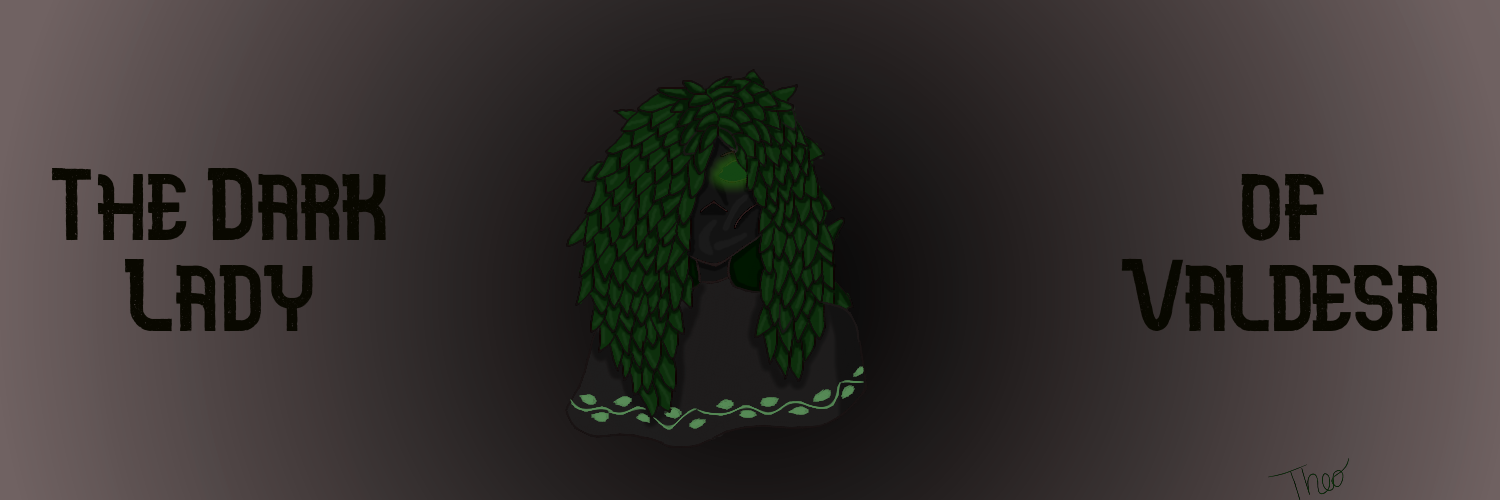The Dark Lady
All art is mine unless otherwise credited <3 -theo/invadersforever
The Dark Lady (a.k.a. The Lady; Lady of the Soil; The Night Queen)
The Dark Lady is one of the oldest and most mysterious of the Valdesan deities. It is unclear where or when she was first worshipped, but she appears in one form or another in almost every culture on Valdesa. Due to her widespread worship, many interpretations of the Lady exist.
"The thing I find most interesting about the Dark Lady is her inexplicable ubiquity. Here we find references to what is undeniably the same figure from cultures who have no other reference of ever meeting. In my opinion, it's entirely possible that worship of some form of the Lady predates the Great Corruption ."a very excited Valdesan anthropologist
"Our Lady will see us through."a Paladin defending Port Dian
"Your "farming" has no place in the Dark Lady's lands!"a fanatic
"By the Dark Lady!"a detective, upon discovering the murderer's identity
"Praise the Dark Lady." "Curse the Lady!"a counterintelligence officer and a spy, at approximately the same time
Related Myths
Rise Of The Great Destroyer Cave Of The Dark LadyDivine Domains
Earth and Soil
The Dark Lady's most popular domain is the nutrient rich soil all elves rely on for their life. This is also the role in which she is most widely worshipped. Some unique interpretations have come out of this however, including her relationship to caves, several cults dedicated to ending farming in Valdesa (elves photosynthesis, so the majority of farming in Valdesa is for financial gain), and a surprisingly popular belief that the Lady is Şiv´ia itself.Life, Hope, and Rain
Hand in hand with her role as an earth and soil goddess is the Lady's connection to life, hope, and rain. As the goddess of good soil, she of course represents the possibility of life. Since she is also connected to the rain, the Lady has come to also be associated with hope throughout many parts of Valdesa. She is often prayed to or evoked prior to battles, negotiations, and other difficult scenarios.The Night, Intelligence, Detectives, and Spies
The Dark Lady has also picked up a connection with the night, intelligence, and craftiness, as these are the traits she seems to encourage most in the heroes she encounters. This also puts her in an interesting position as both the patron deity of detectives and spies. If the Lady smiles on one, the other may lose badly.Mosses, Decomposition, and the Afterlife
The Dark Lady is also associated with mosses, fungi, and decomposition in many inland regions of Valdessa. While rot and mold has a negative connotation as a common threat to elven lives, decomposers are a symbol of life continuing after death. Many cultures believe that the fungus that grows from someone’s body is an anchor for their soul as it prepares to journey to the afterlife.Holidays
The Dark Lady has many holidays, though none of them are widely practiced given her complex nature and varying interpretations. To many who are directly tied to her domains, everyday is a day to celebrate and praise the Lady in hopes of incurring her favour.
The majority of the larger celebrations take place around the change of a season, though which season varies widely. In northern Valdesa, the Dark Lady is commonly celebrated as part of the Winter Solstice celebrations.
Physical Description
Identifying Characteristics
Most depictions show the Dark Lady as a tall, thin female elf with black skin and long, dark leaves. She usually wears a black cloak and a dress made of tall grass. In some regional variations, she is shown to have fungi growing from her shoulders and arms, or be clothed in moss instead of grasses. Almost every depiction shows her to have very unusually shaped face slits. While there are variations in slit shape beyond the most well known rounded and angular, the kind the Dark Lady is depicted with is not found in modern elves. This is believed to be a sign that when the Dark Lady was first conceptualized, these curving slits were a common variety that have since died out.
Divine Classification
Deity
Species
Children
Pronouns
she/her
Gender
female
Related Myths



Comments